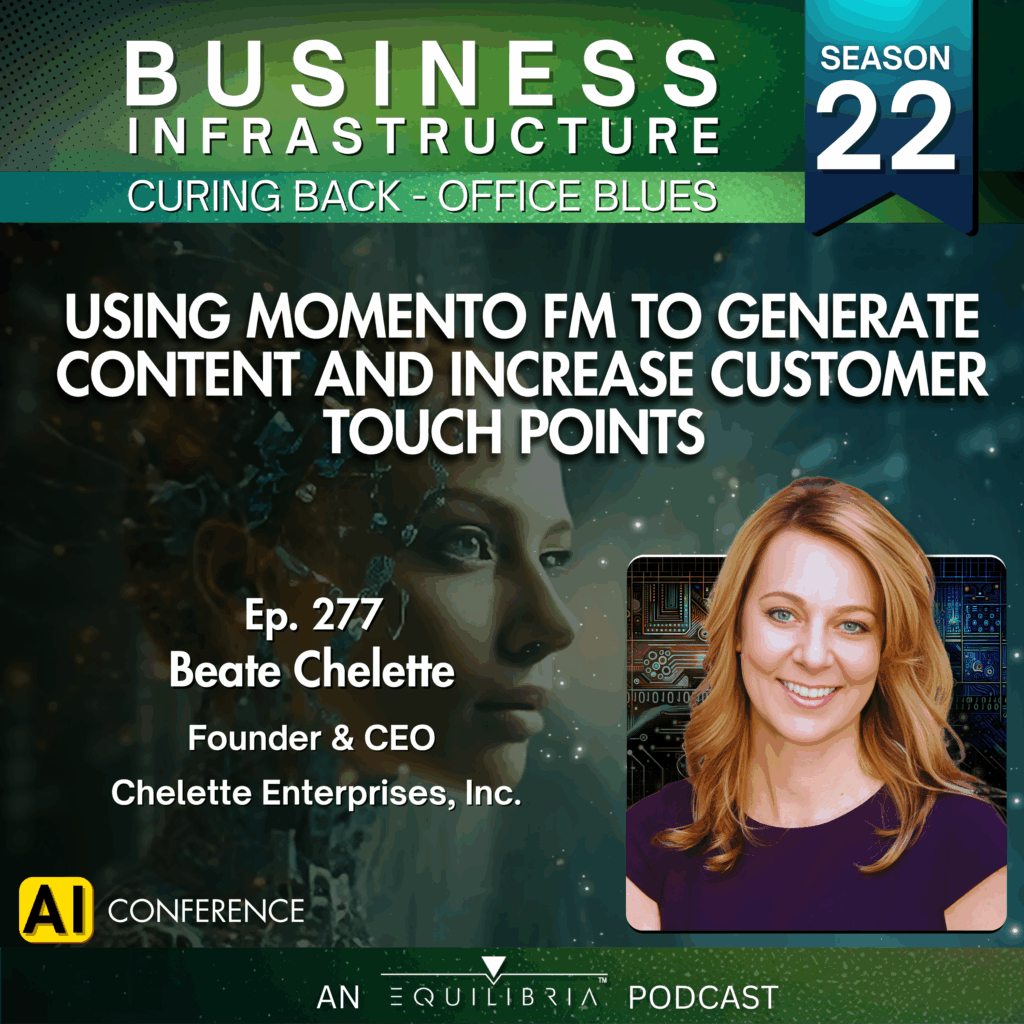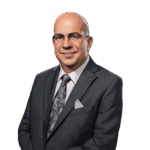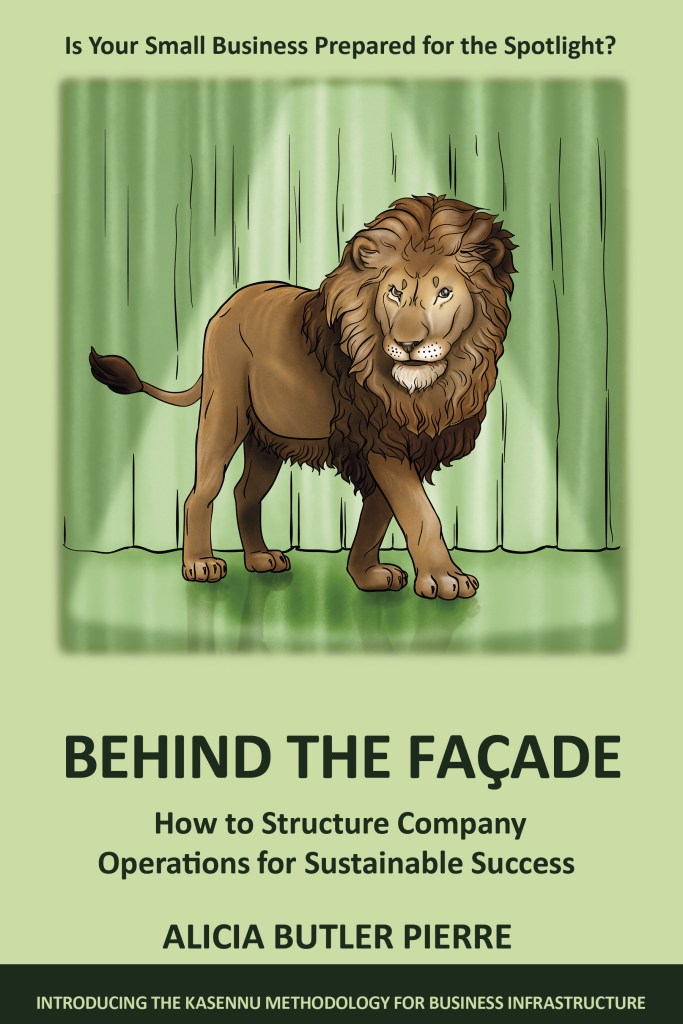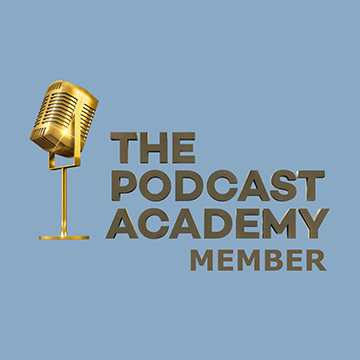Transcript
Is your small business growing faster than you can keep up with? It might be time to grow your team, document key processes, and make sure you’re using the right technologies to scale up operations. In other words, your company might need business infrastructure. At Equilibria, Incorporated we specialize in building business infrastructure.

Equilibria is proud to sponsor this special season which features an AI audio conference to advance your knowledge of business infrastructure. We hope you enjoy this episode!
Welcome back to Season 22 of the Business Infrastructure podcast. I’m Alicia Butler Pierre and on this show, we share operational tips, strategies, and tactics to help you cure any back-office blues you might be experiencing.
I hope you’re ready for the next speaker at our AI audio conference. This speaker was not only recognized as one of the 50 must-follow women entrepreneurs by HuffPost, but she even sold her photography business to Bill Gates.
As a reminder, I’m playing a dual role throughout this episode – part commentator, part participant – all to assist you in following along with what’s going on at the conference. Before we start, I must also remind you of our disclaimer – the nature of AI technology is changing fast, so it’s possible some of the information in this episode might be dated since the original presentation. We encourage you to learn what you can, test it, and most importantly have fun! And now for our next presentation….
This is Episode 277 – Using Momento FM to Generate Content and Increase Customer Touch Points with Beate Chelette.
And hello and welcome, everybody. Welcome to my presentation on podcasts, production optimization. My name is Beate Chelette, and I am the Growth Architect as well as the founder
of the Women’s Code. And we are going to be very specifically talking about one of my favorite tools, Momento FM. Let’s get started.

Okay, here’s something you need to know…I first had the pleasure of meeting Beate when I was a guest on her podcast. I remember researching about her in preparation for that interview. I became enamored with her story – it’s one of unshakeable faith, dogged persistence, and knowing your worth! As she stands on the stage directly facing us in the audience, you can sense that she’s a woman who marches to the beat of her own drum…and I love it! The screen behind her is showing a picture of her as a younger person holding a camera. Pay close attention because it sounds like she’s going to start her presentation by sharing her background.
I’m originally from Germany. I am an immigrant, first-generation immigrant. I started out in the creative aspect of work. I’ve always liked creative, big thinking, big ideas, non-conforming people. And so, I became a photographer. And from there on I realized very quickly that I was better at the business side of things. And it just came really easy to me and so I say this in the context today that I help people “land planes,” because a lot of people like to go to 30,000 ft and they have all these ideas, and then they are unable to ever land a plane and then eventually crashes because you have to refuel it or you have to have some sort of a plan to land it somewhere.
And I was then a photo editor at Elle magazine, went to the United States, became a photographer representative, a photography producer, went through what I call my 13 years of just brutal hardship and survival and bad luck and tragedies from September 11, where I lost a half a million dollars in a day to a lawsuit with an employee that had a business idea which was
my business without me, and a tsunami that killed one of my key vendors, earthquakes, fires, floods, riots…I mean, stuff where you go, Okay, I mean, one of these is fine, two of these maybe, but like, eight of those? And now I added a pandemic to my ever-growing repertoire.
And I was at this point where I had this great idea. I had the stock photography syndication, and I built it, and I was just in a lot of debt because I didn’t have money. And so I’m $135,000 in
debt. I’m going to Germany to drum up some business. My father had pancreatic cancer. My father died six weeks later. And then I am having a complete meltdown. At the funeral my office
calls and says, “We’ve just been served a notice” and I’m losing the house on top of everything.
And that’s it. I mean, it’s game over in everybody’s book. And I had to really learn how to surrender in this moment. I had done everything. There was nothing else I could do. I was physically not able to do anything more. I was financially not able to do anything, there was literally nothing I could do. And then I get a letter from the White House. And in this letter from
the White House a couple of months later, it says, The President sends his best wishes.

On the screen behind Beate, those of us in the audience now see what appears to be a picture of that letter from the President of the United States. She just mentioned this letter was the result of her former mother-in-law’s persistence.
She kept telling me, “You know just go write a letter to the president. If anybody can help you, he will.” And that was so outrageous and so ridiculous to me that I wrote the letter just to not
have to talk to her about this anymore. And so I get the letter from the White House, which really changed my life, because it put me in touch with the Small Business Administration here in Los Angeles. And because the letter came from the White House, they also got a letter from the White House. And then a Bill Gates company comes and says, “Can you tell us how you do it?” And I said, “No, you want it, you buy it.” And I said, “How much do you want?” I said, “A couple of million.” And they said, “Okay.”
Now you understand why I said you should pay close attention to Beate and her story. As entrepreneurs and leaders, how many times have we wanted to give up? The burden can be so heavy sometimes. Yet, something deep inside of us keeps calling us back. It’s a calling that we cannot deny. I’m raising my hand so that I can ask Beate a question…
I’ve had moments like this where I struggle, and I want to just give up and say, “You know, I don’t want to do this anymore, because it’s causing more pain than joy.” If you wouldn’t mind, can you talk a little bit more about that? What is that, that inner thing, whatever you call it, that keeps you going? Do you think you have to be a little bit mad or manic and unrelentless?
Yeah, absolutely. So there’s a series of questions I ask myself. The first question I ask myself, Is what I’m trying to do possible? Do I know anyone who is doing what I’m trying to do? Does it
exist? So, in this particular case, that would have been, are there successful stock photography syndications? Absolutely, there are. Good. So then if it exists, then it must be possible for me.
Then the answer to that is Yes.
Then the next question isn’t, Can I? But the next question is, How can I? And so when you ask yourself these questions in the right order, is it possible? If it’s possible, it’s possible for me! If it’s possible for me, then the question is how? Then suddenly the whole thing changes. And so, yes, I could have given up, but I knew there were people that did it. And I had a friend who’d had a $70 million exit. Now, I didn’t have a $70 million exit, but he had a $70 million exit. So I knew it was possible. It literally happened right before my eyes. And he says, “You’re going to be next.” I said, “What are you talking about?” And I was next.
This question must have been a natural segue to the next slide of Beate’s presentation, because now we see a picture of her in an office following the sale of her photography business to Bill Gates. To the right of that picture is an image of her book.

I took a job at this Bill Gates company, and I became the global director of photography. And I realized on what really happens in Corporate America, and I thought it was repulsive. And how women are treated in Corporate America, how the whole Men’s Code works, and how the women don’t have a code. And that’s when I sat down and I wrote a book, The Women’s Code,
where I realized that it’s not just the men, it’s a lot of times the women that are the worst with each other. How can we expect that the world is going to support us if women don’t even
support other women? And frankly, how can I be mad at a man when a man says, “Look, if half of my competition takes each other out, why should I get involved?”
And I looked at this and I said, that’s what’s happening. Women are at each other’s throats. They’re so busy with taking each other out. And they go like that, bleep word, wants my job.
When men go into an organization, they say to the boss, you do know that the only reason I’m taking this job is because I want your job. And then that guy is going to say, “Great, that’s what I was hoping you were going to say because I want my boss’s job!” Women don’t do that. And so I really got involved in the Women’s Code and wrote the book Happy Woman, Happy World to outline for women what it’ll take to have a code and then to help men, also to understand how to help women.
And I am really sad to say that not much is changing, unfortunately, and that we are reverting back to things that I fought for, what, 20, 30, 40 years ago? I never thought I have to talk about women’s rights again. I never thought I had to talk about equality again. I thought we already had all these conversations. We keep going back to the same thing over and over and over again. And it is because people don’t like to change and people don’t like to move ahead, which is what’s going to bring us to our next topic, which is AI, because this is all about change and it is all about, Now what are you going to do with that?
Because garbage in, garbage out. False information in, false information out. So what is our responsibility as we are going into this new world? A moment only comparable to when the
Internet first came out.
And I remember when I got my first computer, I used to be on a floor with a telex machine and it was only reserved for absolute emergencies. And there were two in the entire building of the big publisher and I had access to one of them so I was very privileged that I could do that. And then one day, somebody brings me, well, first the fax machine that was game-changing, and then a computer. And from there on, and then the whole Internet exploded. And I think we are in a moment, very much like that right now.
Beate just advanced to the next slide of her presentation. It shows a multi-colored logo that appears to be in the shape of an aircraft with the title The Growth Architect underneath it.
Primarily today I work as a growth architect to work with people that need one out of three things. They either want to turn their talent into a business – that means they need to build the
business and the business model. Or they need a system with a differentiation factor where all their knowledge is neatly put under one umbrella, which we call the Signature Growth System, or they have a business and it makes money, and now they really need to seriously scale. And that’s when they come for optimal growth alignment, and we’re building out this plan on how to scale a company. So that’s the three pieces that I primarily work on. The Women’s Code is always going to be my love child, because I do love working with women, and I certainly have a lot of experience in shortcuts and understanding of what can happen.
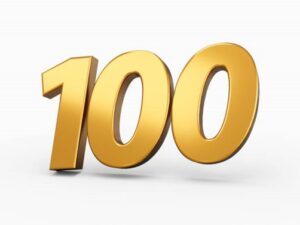
Beate just clicked to her next slide. It shows a cover image for The Business Growth Architect Show. It’s yet another one of her accomplishments. They’re celebrating their 100th episode. What’s interesting is that the bottom of this slide also has the words “podcast hosting” on one side and “podcast guesting” on the other side.
We looked at the Business Growth Architect Show, and we said, well, the only reason we would want to do this is because we need some sort of a system behind it, or the process behind it has to do something. The people that go on the show are either potential clients or people that elevate us.
There is nobody else that can go on the show because there’s no reason I need to give somebody a platform where I have no benefit from that. So you have to be very clear about when you do that. Yes, the quality of the conversation is really important, but you also need to think about, do you want to be liked or do you want to make money? And between the two of them, I probably take the let’s make some money, and then we can figure out if we like each other.
The guesting is very much a lead generation piece where we select podcasts where we do believe that the host could use one of our programs. When we go on the podcast, we offer a brainstorming session, because I have a lot of credibility in the market and people pay a lot of money to talk to me. So when I go on a podcast. Oftentimes the podcast is a live coaching session, where you let people really see how you work.
And oftentimes stuff already comes up and I can help myself and this is what I do, where then the host says, “Oh my God, this was amazing! Thank you so much for that.” And then after the
show, I say, “Listen, there’s a couple of things you talked about. Why don’t we get on a brainstorming session? I’ll be happy to put my brain into your business and let’s talk for like 15, 20
minutes, 25 minutes, and whatever we come up with, it’s yours. If I can help you, I’ll tell you. If I can’t help you, I will tell you. If I know somebody who can help you, I will tell you.” And then it becomes a warm conversation that is not so threatening to a lot of people like a cold call.
Now that we know Beate’s backstory, her work with the Women’s Code, and how she leverages podcasting as a business development tool, it makes sense that her next slide shows a screenshot of Momento FM. This is the AI tool that she’s going to tell us more about.

We use Momento FM, which happens to be one of my favorite tools. Momento allows me to take my podcast and dump the whole thing into this platform. And what it does, it pulls out
highlights and quotes and headlines and title suggestions and metadata and tags and social media blurbs for X, for Facebook, for LinkedIn. And so when we give the command and we put it
in, it automatically generates all of that for us. And then we export that based upon some of the prompts that they have prewritten and some of the prompts that we use. And then the amount of time for our show notes and to get this ready has dramatically reduced. I mean, we really don’t need a writer anymore.
On the other hand, it adds more to my plate because AI, you often can tell when it’s written by AI, because AI uses words like “delve,” like who the heck uses the word “delve” or “crucial?” I
mean, there’s a couple of words AI uses where you go, “Dude, you sound like my grandfather.” And so you have to pay attention to when you go into these systems where you then double
check and make sure that some of the things are within context. Momento also has an ability to do a short editing for shorts. So you can take not just your audio, you can take your video and put your video in it. And then it has a lot of editing tools to allow you to edit directly in Momento, your shorts for your podcast.
Hmm…this is very interesting because there’s no shortage of AI tools that can take audio and create things like descriptions, transcripts with timestamps, and even articles, but Momento can also automatically create shorter-form content from your video files. I have another question for Beate.
Can it take that raw video and say, “Oh, based on what we’ve quickly analyzed, this is what we recommend might make a successful short on TikTok or YouTube?” or something like that.
It doesn’t really have the capability to tell you what will make it successful, but what it will do it will give you some highlights of this. And then when you have the highlights, then you kind of can see the moment, they call it the moments. And then you can select the clip and continue directly in the editor and then write this. But I’d be happy to show it to you.
Okay, Beate is walking over to the podium where there’s a laptop so she can give us a demo of Momento.
As you can see here, it comes up with these suggestions. And then you go in the editor and then you can pick the type of…so you know, you see that this was a side-by-side video. So you can
pick this and you have multiple templates. It also has the ability to post directly to social, it has different presets, you have different types of fonts available to use. So it actually goes pretty
quickly. So if I was somebody who was just starting out and the magic emojis, it’ll automatically apply emojis to the transcript.
And I don’t know if it’s going to do it because we need a significant amount of bandwidth for the video here. We sometimes add some shorts just for the copy. When I click on the moments,
it gives me an option for 22 different shorts.

Okay, let me explain what we in the audience just saw. When Beate logged into her account at Momento.FM, we could see the transcript for a video she previously uploaded on the far left of the screen. Directly in the middle of the screen are various options for editing the video and on the far right are different templates you can select based on short snippets of the original video. Beate mentioned that it can take about 30 minutes for the video to process.
It has an editor right here. And when you go into the editor, you have different frames, you have different fonts. You have, you can add…it magically cuts it so it takes out filler words, it adds
emojis, you can add b-roll. It’s a pretty sophisticated system and they’re still adding stuff left and right so it’s a really fabulous tool and it’s kind of cool to see how quickly all of this is happening. And they’ve added this piece where now you can also post it directly to your social.
This is very cool! In the upper right corner of the screen is a purple button that says, “Post to Social.” Okay, I’m going to ask another question.
So, on average Beate, how many individual pieces of content would you say that your team is able to generate, let’s say just from one interview on your show?
40.
40? Wow! Do you all actually put all of that out there? Is it spread out over a certain time period?
We don’t look at it from content. We look at it from touch points. So we do about 30 to 40 touch points. The touch point is a short that will go on as a reel that will go on as a YouTube short that will go on LinkedIn. So that’s already three touch points right there. And we generate content with the most number of touch points across as many different platforms as we can have.
Honestly, I wouldn’t expect anything less than that from Beate. Not only is Momento an effective way to generate content, but it sounds like, through a filtering process, she and her team intentionally select the short videos that will work well across multiple platforms. As we all know, audiences have different expectations across different platforms like Instagram, YouTube, and LinkedIn. The fact that they can use one video for multiple touch points and generate high engagement across each of them is amazing.
Beate just walked back to the center of the stage. There’s now a slide showing the role that a tool Momento plays in the business infrastructure she’s built to scale her own business. As a reminder, business infrastructure is a system for linking people, processes, and tools to achieve repeatable, sustainable and profitable scale.
I have a video editor. And then we have my virtual assistant who has a team of, I think, three or four people that she works with. And we have designed entire workflows in our project management software, Asana. Every podcast has, I want to say, about 60 different steps to it until it gets published.
The copy editor we don’t use anymore. So we used to have a podcast production company that we let go, and we used to have a writer that we let go, and we took, we put that into a better
video editor. And the better video editor then creates the audio, and then we upload it ourselves to the distribution service for the podcast. And that saved us a lot of time and money on the
podcast production because we found that they were using AI, but we didn’t like their AI solution as much as we liked ours.
Aha, now this is interesting. Did you catch what Beate just said? Because of Momento, she’s actually replaced two people with a technology and what she described as a better video editor. Someone else in the audience just stood up to ask a question.

Hmm…okay this person just made an interesting point. He mentioned that, so far in this AI audio conference, other speakers have said the goal of AI isn’t replacing people, but to upskill them instead. But Beate effectively did in fact shed one net person because of AI technology. He asked if she could speak further about this.
Number one, I mean when the Internet first became the Internet, people were like, Well, why would anybody need a website? And now, unless you have a website, it’s nothing. I use AI for
everything. I have a process in place, and we’re constantly looking for other tools where I now take the work that I do on the higher end level, where I do the growth strategies, and I take
conversations that I have with clients over weeks, often months, and then I take these and I build entire plans, launch plans, just based upon what we talked about. And I run it through AI, and then I do a six months launch plan based on that. Yesterday, I had a conversation, I had a brainstorm with a new client, and we went through what it could be, and what it couldn’t be. We literally were brainstorming. Then I ran it through AI. I say, run me a SWOT analysis on the different ideas. Tell me what these different ideas were. That would have taken me normally at least an hour to write. I had that thing written in ten minutes.
And it’s no secret that doing more in less time means more revenue…and as Beate is showing on her next slide, it’s also translated into better quality results.
I have found that AI sometimes goes and it just comes up with something really random, and it’s still kind of like a child. So when I then say, “That was really terrible, you misunderstood.” Then it says, “Oh, I’m sorry I misunderstood.” But then on the second, suddenly, magically, it figured out what I wanted. So there’s definitely some intricacies in there where I’m very curious, sort of on the programming side of things, on OpenAI, how that kind of worked. But I love it. I use it every day. I use it for everything. It’s always open.
Now Beate is showing a slide that includes the logos of a few other AI tools.
Another tool that I use is MaxAI.me. That’s one of my favorite tools. So you just also have to constantly look at what the different plugins are for AI, for Chat GPT, and see what is out there. MaxAI.me, and Momento, along with Chat GPT, are probably things I use the most.
Ah, there it is – a slide about Beate’s podcast. With all the talk about Momento and how she and her team uses it to feed podcast content into, I’m glad she’s going to share more about her show.
My podcast is the Business Growth Architect Show. And our episodes are all around strategy and how do you build, grow, and scale a business, grow your authority and scale your impact?
We literally just launched a quiz and we realized that a lot of people are very concerned about should we go into business? What’s my earning potential? How much money can I make? So I
came up with a quiz. I came up with a profit formula. So you go to WhatsYourTalentWorth.com and take the quiz, and it will give you the actual number of your earning potential. Now, what people will find is that there’s going to be a discrepancy between what their earning potential is and what they’re earning right now. Which is exactly why you and I are in business. Because if you can make this much money and you’re not, you need a business growth consultant to help you to do that.

I also have a group, The Women’s Code, also on LinkedIn. And we have now a Facebook group called Turn Your Talent into a Business. Because we’re really realizing the potential in the market right now that people wanting to go out on their own or figure out what entrepreneurship might look like.
I just noticed Beate looking down at the timer in front of her on the stage. I know there’s so much more we can learn from her, but I can tell from the look on her face that it’s time to wrap up. There are still a lot of people raising their hands to ask her questions too. The room moderator just thanked Beate for her insightful presentation and demo of Momento and encouraged everyone to connect with Beate on social media to ask her any additional questions.
Thank you for having me.
Kudos to Beate for creating different online communities for entrepreneurs to come together and learn from each other about how to build, grow, scale, and land that proverbial business plane she talked about in the beginning.
You can access quick links to Momento FM as well as the resources Beate mentioned at BusinessInfrastructure.TV. That’s BusinessInfrastructure.TV. You’ll also find the video version of this presentation and demo there too. Remember that disclaimer I gave at the beginning of this episode – you know, the one about technology changing fast? Well, sure enough, Momento FM is no longer called that. It’s now called Minvo. But rest assured, all the links we provide in the show notes will direct you to the right place!
Thank you for listening! If you enjoyed this episode, then please subscribe and give us a five-star rating and review.

We hope you learned some actionable things to start improving your company’s back-office operations. Next up we’ll feature a demo from our team’s very own video editor.
You’re guaranteed to learn something new that can get your company more exposure so be sure to come back to the place wherever you’re listening to this episode, so that you don’t miss that demo! Until then, remember to stay focused and be encouraged. This entrepreneurial journey is a marathon and not a sprint.
This episode was produced by me, Alicia Butler Pierre. Audio editing by Olanrewaju Adeyemo. Voiceover by Kenya A. Moses. Original score and sound design by Sabor! Music Enterprises. Video editing by Gladys Jimenez. A special thank you to Grant Revilla for creating the show notes.
This is the Business Infrastructure – Curing Back-Office Blues podcast.


